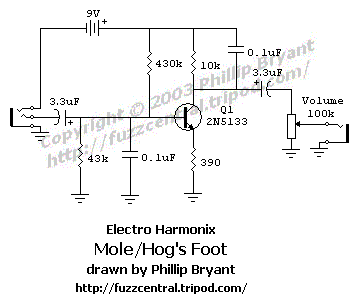BuddytheReow
Moderator
Hey Guys,
Since I got my bass last week I wanted to put together a simple little circuit for it, and I'm currently in the breadboard phase. At first I wanted to do a Bazz Fuss with large in/out caps with a simple volume control. Then I realized it would sound better to allow some of the raw signal into the mix for nice tweakability. The issue I ran into quickly is that there is a big volume difference between the two, so I want to put a clean boost instead of raw signal. I chose an lpb1. Both circuits work fine as standalones, but trying to blend the two is causing some issues. I want to have the signal 100% boost or 100% fuzz when the blend control is turned to the extremes, but I have a small amount of fuzz when i'm dialed into boost and vice versa. Lug 1 is the BOOST, lug 3 is the FUZZ, and lug 2 is output. I upped the blend pot to 1m and don't have a bigger value in my inventory. Is there a way to fix this or a piece that i'm missing? Maybe dump some signal to ground on both sides? I read somewhere that an input buffer may fix this?


Since I got my bass last week I wanted to put together a simple little circuit for it, and I'm currently in the breadboard phase. At first I wanted to do a Bazz Fuss with large in/out caps with a simple volume control. Then I realized it would sound better to allow some of the raw signal into the mix for nice tweakability. The issue I ran into quickly is that there is a big volume difference between the two, so I want to put a clean boost instead of raw signal. I chose an lpb1. Both circuits work fine as standalones, but trying to blend the two is causing some issues. I want to have the signal 100% boost or 100% fuzz when the blend control is turned to the extremes, but I have a small amount of fuzz when i'm dialed into boost and vice versa. Lug 1 is the BOOST, lug 3 is the FUZZ, and lug 2 is output. I upped the blend pot to 1m and don't have a bigger value in my inventory. Is there a way to fix this or a piece that i'm missing? Maybe dump some signal to ground on both sides? I read somewhere that an input buffer may fix this?









